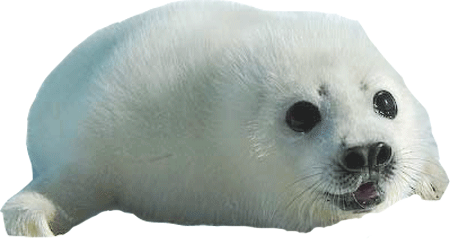Harp Seal

Scientific Classification
Kingdom: AnimaliaPhylum: Chordata
Class: Mammalia
Order: Carnivora
Family: Phocidae
Genus: Pagophilus
Species: groenlandicus
Description
Harp seals are part of the family Phocidae, known as the "true" or "earless" seals as they lack external ear flaps. They have a robust body, a comparatively small, broad, flat head, and a narrow nose that contains eight pairs of teeth in both the upper and lower jaws. Their front flippers have thick, strong claws. On their hindflippers, the inner and outer digits are longer and have small, narrow claws. Adults are about 5-6 ft (1.7 m) long, and weigh around 300 lbs (135 kg). They have light gray fur, with a black face and a horseshoe-shaped black burden on their back.
Size
At birth, harp seals are just less than 3 feet (1 m) long, and weigh about 25 lbs (11 kg). Called "whitecoats," newborns have long, wooly, white fur known as "lanugo", and undergo a difficult series of "molts" previous to reaching adult coloration. Harp seal pups are suddenly weaned from their mothers when they weigh approximately 80 lbs (36 kg).
Diet
They eat a variety of fish and invertebrates, but mostly focus on smaller fish such as capelin, arctic and polar cod, and invertebrates with krill.
Habitat
Harp seals arise in the pack ice during much of the North Atlantic and Arctic Oceans. They can be found from Newfoundland to northern Russia.
Distribution
The harp seal population is separated into three part stocks, and each uses a specific breeding site. The first and largest, the Western North Atlantic stock, is situated off eastern Canada and is divided into two herds based on breeding location. The Front herd breeds off the coast of Newfoundland and Labrador, and the Gulf herd breeds close to the Magdalen Islands in the center of the Gulf of St. Lawrence. The second stock breeds on the "West Ice" off eastern Greenland, and the third stock breeds on the "East Ice" in the White Sea off the coast of Russia. Breeding occurs between mid-February and April, at varying times for each stock.
Population Trends
Abundance estimates, which use a variety of methods with aerial surveys and mark-recapture, are obtainable for the Western North Atlantic stock. These methods engage surveying whelping concentrations and estimating total population adult numbers from pup production. The best approximation of abundance for Western North Atlantic harp seals is 5.9 million animals. The minimum population estimate based on results of a 2004 pup survey is 5.3 million seals.
 Deep Sea Crabs
Deep Sea Crabs